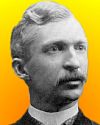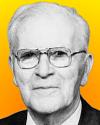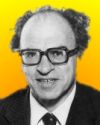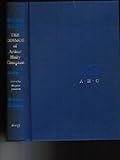 | TODAY IN SCIENCE HISTORY NEWSLETTER - 10 SEPTEMBER |
| Feature for Today |
 On 10 Sep 1857, James Keeler was born, the American astronomer who used spectroscopic observations to confirm that the rings of Saturn were not solid, but composed of meteoric particles, as predicted in theory by Maxwell. In his relatively short life (he died at age 42) he established a reputation for the accuracy of his measurements of spectra of stars and planets. He discovered and measured the motion of nebulae. On 10 Sep 1857, James Keeler was born, the American astronomer who used spectroscopic observations to confirm that the rings of Saturn were not solid, but composed of meteoric particles, as predicted in theory by Maxwell. In his relatively short life (he died at age 42) he established a reputation for the accuracy of his measurements of spectra of stars and planets. He discovered and measured the motion of nebulae. In the biography for James Keeler, astronomer, in The National Cyclopedia of American Biography you can learn that, like some other astronomers, he gained the interest as a lad, and made his own telescope with which he viewed Saturn. He went on expeditions, worked at several observatories, and wrote extensively for technical publications. Special Request: Please contribute your ideas for the five physicists that anyone should know because their work has been beneficial in their life. See the webpage Five Famous Physicists You Should Know. And Why. There is a rubric in which your webmaster has outlined the idea that there are physicists worthy of recognition by the public at large who are relatively unknown. See the first nomination for possible inclusion on the list, and comment if you agree or not.. (Isn't it a travesty that teenagers, and many elders too, know the names of countless sportsmen and bands, but not physicists who have made their lives so much better?) Please use your mail reader reply, or website feedback menu button, to write your suggestions, and why. Thank you. Correction to 9 Sep Newsletter, with thanks to a sharp-eyed reader. The first Saturn V rocket test was not on 9 Sep, but was actually 9 Nov. The website entry has been corrected and expanded. |
| Book of the Day | |
|
| Quotations for Today | |
 | Yet is it possible in terms of the motion of atoms to explain how men can invent an electric motor, or design and build a great cathedral? If such achievements represent anything more than the requirements of physical law, it means that science must investigate the additional controlling factors, whatever they may be, in order that the world of nature may be adequately understood. For a science which describes only the motions of inanimate things but fails to include the actions of living organisms cannot claim universality. |
 | Life is a copiously branching bush, continually pruned by the grim reaper of extinction, not a ladder of predictable progress. |
 | Every work of science great enough to be well remembered for a few generations affords some exemplification of the defective state of the art of reasoning of the time when it was written; and each chief step in science has been a lesson in logic. |
| Quiz | |
| Before you look at today's web page, see if you can answer some of these questions about the events that happened on this day. Some of the names are very familiar. Others will likely stump you. Tickle your curiosity with these questions, then check your answers on today's web page. | |
| Births | |
 | Waldo Semon, born 10 Sep 1898, was an American chemical engineer who invented a plastic now produced in larger quantities than any other plastic except polyethylene. In 1926's, he discovered how to convert it from a hard, unworkable substance to a pliable one. It is now used in hundreds of products such as floor tile, garden hose, imitation leather, shower curtains, and coatings. What is this popular plastic? What is this popular plastic? |
 | Arthur Holly Compton, born 10 Sep 1892, was an American physicist, engineer and a joint winner of the Nobel Prize for Physics (1927) for his discovery and explanation of what is known as the Compton effect.  What is the Compton effect? What is the Compton effect? |
| Deaths | |
 | Sir George Thomson (1892-1975) was an English physicist who was the joint recipient, (with American Clifton J. Division), of the Nobel Prize for Physics in 1937 for demonstrating that electrons exhibit a certain property of waves.  What wavelike electron phenomenon did he demonstrate? What wavelike electron phenomenon did he demonstrate? |
 | Sir Hermann Bondi (1919-2005) was an Austrian-born British mathematician and cosmologist who, with Fred Hoyle and Thomas Gold, formulated a theory to explain the universe that was different from the “Big Bang.” What was the theory of the universe put forward by Bondi, Hoyle and Gold? What was the theory of the universe put forward by Bondi, Hoyle and Gold? |
| Events | |
On 12 Sep 1912, Carl Fisher brought together a group of prominent men from the auto industry for a dinner in Indianapolis, at which he pitched his idea of a transcontinental highway. It would be a surfaced road to join the east coast of the U.S. to the west coast. It became an all-weather road for the use of the automobiles those leaders were then manufacturing. What was this transcontinental road named? What was this transcontinental road named? | |
 | On 10 Sep of a certain year, Alec Jeffreys realized the possibility of DNA fingerprinting for a person's unique identification. That idea was an accidental outcome of research on genetic markers for inherited illness. Two years later, the first use of DNA profiling in criminology proved innocence. In which decade was DNA fingerprinting introduced? In which decade was DNA fingerprinting introduced? |
| Answers |
| When you have your answers ready to all the questions above, you'll find all the information to check them, and more, on the September 10 web page of Today in Science History. Or, try this link first for just the brief answers. Fast answers for the previous newsletter for September 9: the rate of flow of electromagnetic energy • Luigi Galvini • starch • X-rays • moth • Radio Corporation of America (RCA). |
| Feedback |
 If you enjoy this newsletter, the website, or wish to offer encouragement or ideas, please send feedback by using your mail reader Reply button. If you enjoy this newsletter, the website, or wish to offer encouragement or ideas, please send feedback by using your mail reader Reply button. Your click on a StumbleUpon, Google+ or Facebook social button on the site webpages is also a welcome sign of appreciation. Thank you for using them. |
| Copyright |
| To find citations for quotations go to the corresponding webpage by clicking on the “quotes” balloon icon. Sources for the thumbnails appear on today's webpage with the corresponding item. � This newsletter is copyright 2013 by todayinsci.com. Please respect the Webmaster's wishes and do not put copies online of the Newsletter � or any Today in Science History webpage. (If you already have done so, please remove them. Thank you.) Offline use in education is encouraged such as a printout on a bulletin board, or projected for classroom viewing. Online, descriptive links to our pages are welcomed, as these will provide a reader with the most recent revisions, additions and/or corrections of a webpage. For any other copyright questions, please contact the Webmaster by using your mail reader Reply button. |
--
If you do not want to receive any more newsletters, Unsubscribe
To update your preferences and to unsubscribe visit this link


Δεν υπάρχουν σχόλια:
Δημοσίευση σχολίου